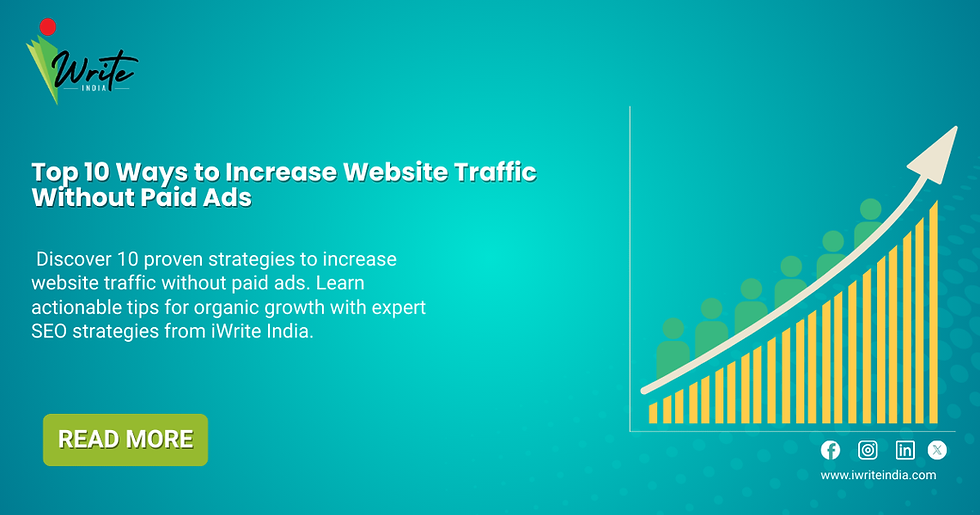Generative Engine Optimization (GEO): The New SEO for AI Answers
- iWrite India
- Jun 24
- 4 min read

Generative Engine Optimization (GEO) is the future of online visibility. As AI-generated answers increasingly dominate search results, businesses must rethink their SEO strategies. GEO focuses on optimizing content not just for humans and traditional search engines but also for AI models like ChatGPT, Google SGE (Search Generative Experience), and Bing Copilot.
Unlike traditional SEO that relies heavily on links and keyword density, Generative Engine Optimization is about structuring information for better AI understanding, retrieval, and summarization.
Why GEO Is the New SEO in 2025
Generative engines are changing how users search. According to Gartner, by 2026, 30% of web browsing will be screenless, driven by voice and generative AI interfaces. And with over 70% of Gen Z preferring conversational queries, Generative Engine Optimization is not optional, it's essential.
AI generated content is already appearing above blue links in search. If your brand content is not structured for these engines, you are invisible to the future.
GEO vs Traditional SEO: Key Differences
Understanding how Generative Engine Optimization differs from traditional SEO is essential for adapting your content strategy in 2025. Here are the key distinctions:
Focus: Traditional SEO centers on ranking for keywords in search engine results. GEO focuses on contextual relevance and structuring content for AI-generated answers.
Target Audience: SEO targets search engine crawlers and human searchers. GEO targets large language models (LLMs) like ChatGPT and Google SGE.
Content Structure: Traditional SEO emphasizes headers, metadata, backlinks, and keyword placement. GEO prioritizes clear, conversational, and structured content that AI can easily parse and quote
Discoverability: SEO aims for a higher position in SERPs (Search Engine Results Pages). GEO ensures inclusion in AI-generated summaries and zero-click responses.
Success Metrics: SEO success is measured through traffic, bounce rates, and click-throughs. GEO measures success via AI citations, visibility in AI chats, and authority in zero-click answers.
How to Optimize for Generative Engine Optimization
1. Use Structured, Fact-Based Content
AI prefers content that is crisp, sourced, and to the point. Avoid fluff. Every sentence must answer a potential query.
2. Add Semantic Layering
Use semantic keywords around your main topic to help generative models pick up contextual meaning. This improves the chance of AI citing your content.
3. Include FAQ Blocks and Featured Snippet Answers
Break down content into Q&A format with straightforward language. Generative engines love structured, easy-to-quote segments.
4. Build Topical Authority with GEO
To truly win at Generative Engine Optimization, go deep into one niche. A single, focused content cluster outperforms scattered blogs in AI-based retrieval.
5. Leverage AI Generated Content the Right Way
Use AI generated content as a first draft, not the final one. Human editing, fact-checking, and tone personalization are critical for trustworthiness.
6. Optimize for Zero-Click Experiences
Include value upfront. With zero-click becoming common, readers may not visit your site unless the AI answer shows strong authority and relevance.
Why Generative Engine Optimization Matters for Brands
When you invest in Generative Engine Optimization, your brand becomes part of the AI knowledge layer. This positions you not just for traffic, but for trust. AI models reward consistent, verified, and expert content.
If you’re a brand or business looking to stay visible in 2025 and beyond, GEO is the edge you need. Whether you're creating AI generated content or targeting search engines, your strategy must evolve.
What is Generative Engine Optimization?
Generative Engine Optimization is the process of structuring and enhancing online content so that it is selected, summarized, and cited by AI tools like ChatGPT and Google SGE. It focuses on context, clarity, and relevance to be visible in AI-generated answers.
CTA for iWrite India
Want to make your content AI-ready? At iWrite India, we specialize in future-forward SEO strategies, including Generative Engine Optimization that helps your brand rank not just on Google, but also in AI-generated answers. Let’s turn your website into an AI-favored source of truth.
FAQs
1. How is Generative Engine Optimization different from AI generated content?
Generative Engine Optimization refers to optimizing human-created or AI-assisted content for discovery by AI models, while AI generated content is the content itself produced by generative tools. GEO ensures that whatever content is published, it is structured in a way that AI tools can understand and use it effectively.
2. Is Generative Engine Optimization relevant for local businesses?
Absolutely. Even local queries like “best dentist near me” are now answered by AI engines. Optimizing your local pages for GEO ensures your business gets featured in these AI responses. For example, if you're a local SEO Agency in Delhi, GEO can make you the top recommendation.
3. Can I use AI generated content to do GEO?
Yes, but it must be human-edited and fact-checked. Generative Engine Optimization demands factual accuracy, clear formatting, and semantic richness that raw AI output often lacks. Always combine human expertise with AI efficiency.
4. What industries benefit most from Generative Engine Optimization?
Industries with high informational intent such as healthcare, finance, education, and tech benefit the most. GEO makes your brand visible at the information layer, not just the search layer.
5. How do I know if GEO is working?
Track your brand mentions in AI platforms like ChatGPT, Google SGE, and Bing. Monitor zero-click engagement, citations, and voice search inclusions. Partnering with a trusted SEO agency in Delhi like iWrite India can help track and improve your GEO outcomes.




![Top 5 Digital Marketing Agencies in Delhi [2025 Updated]](https://static.wixstatic.com/media/53afe3_a718f2b4f3ae4a75becb77146127a742~mv2.png/v1/fill/w_980,h_515,al_c,q_90,usm_0.66_1.00_0.01,enc_avif,quality_auto/53afe3_a718f2b4f3ae4a75becb77146127a742~mv2.png)

Comments